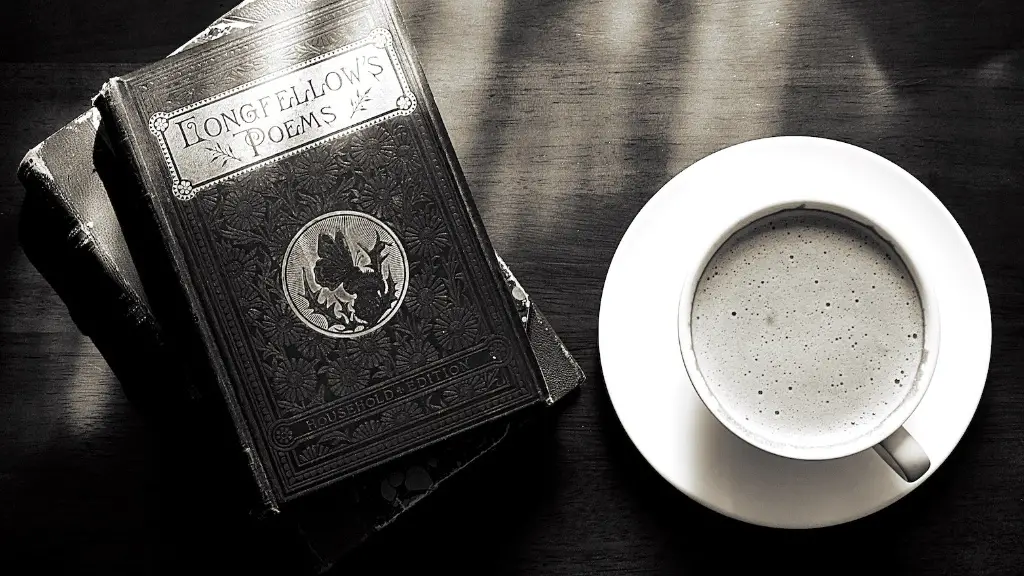Robert Frost wrote some of the most recognized poems in the English language. From “The Road Not Taken” to “Stopping by Woods on a Snowy Evening,” Frost’s poems often celebrated the beauty of everyday moments and the power of choices. But why did Frost begin to write poems in the first place? Throughout his lifetime, he crafted numerous poems, stories, and essays that are still widely read and admired today.
According to Frost’s biographers, he started writing poetry in his teens, during the late 19th century. His earliest works were sketches, often about his New England upbringing, which began to take on a more sophisticated form as Frost gained experience. As Frost matured and honed his writing style, he was able to effectively convey his innermost thoughts and feelings through the medium of poetry.
Frost was also inspired by his readings of various authors, including the British Romantics, Transcendentalists, and Modernists. He found how these authors used word choice and meter to convey emotion and build tension, which helped him develop his own unique writing style. Additionally, the combination of his New England upbringing, with its austere beauty, the changing landscape of the world, and his admiration of different authors, created a perfect storm that fostered his creativity.
Frost also wrote to provide readers with an honest look into life’s perplexing questions and moments. By presenting his interrogations and concerns through his writing, Frost used his work as a vehicle to provide comfort to communities in similar difficult times. He was able to use his works to make sense of life’s complexities, bring solace to others, and to unearth essential truths.
In addition to paying homage to authors he admired and searching for answers to life’s questions, Frost started writing poetry to express abstract ideas and emotions, by using sensory images and symbols. By doing so, he transformed his writings into something timeless and universally understood. His legacy lives on today, as his works provide readers with an inspiring glimpse into the power of the human spirit.
Rise of Fame
As Frost’s writing matured, he began to receive recognition for his works. He was well known for his poetic structures, where he blended strict and free forms of meter, as well as his skillful use of symbolism and imagery. Many of Frost’s works have been seen as quintessential examples of American poetry and lauded for their representation of American life. His success spanned the United States, Europe, and even India. His works were even praised by the likes of W.H. Auden and noted philosophers, such as John Dewey.
Frost’s success was not only limited to the literary world. His works were popularized by the media and other famous figures, such as Franklin D. Roosevelt and Robert Penn Warren. Frost was even asked to write two poems for President John F. Kennedy’s inauguration in 1961. With increasing numbers of public admirers, Frost earned the title of “America’s Poet.”
Yet, Frost was not without criticism. His work was often seen as too “folksy” and too simplistic by some critics either. Amidst his fame, Frost was consistently mindful of readers and their perspectives, which stayed with him throughout his lifetime, as he crafted stories for both the masses and those he hoped would come to appreciate his works.
Legacy
Frost was one of the most prolific American authors of his time and his best-known works still have a strong presence in popular culture and literature. He employed his work to present complex messages in simple forms and explore the beauty of everyday life. Many of his works emphasize the power of decision making and grapple with themes of death, mortality, and human frailty.
Frost’s efforts to connect to different readers and explore the power of creativity were part of a lifelong practice. His works still provide the same effect today, with many readers using his works to form connections and discover truth for their own lives. As time passes, Frost’s works continue to leave their marks, making his timeless pieces and messages even more meaningful.
Writing Style
Frost’s writing style was primarily structured within the parameters of traditional open forms such as the iambic pentameter and the sonnet. At the same time, he often blurred the lines between these forms and wrote in more irregular patterns. By doing this, he was able to create a uniquely rebellious style and a mix of folk and literary tradition.
Frost often experimented with the combination of rhyme and syllables, utilizing the perfect rhyme, slant rhyme, and couplets. Moreover, his works communicated the physical, emotional, and spiritual aspects of life, while still containing the truncated, incomplete nature of the human experience. Therefore, Frost’s style of writing felt both modern and timeless.
Furthermore, Frost consciously adjusted his writing style in order to provide the reader with each poem’s effect. Knowing full well he had the capability to do so, he also adapted his style to fit the times. He creatively used traditional forms, rearranged them to fit modern sensibilities, and infused the resulting poetry with his own insights and understanding.
Frost’s deliberate use of detail, imagery, and tone contributed to his success as a poet. Bywriting with a simplicity and transparency, he conveyed the human condition better than most of his contemporaries. Frost’s works were accessible to a wide audience, and his clarity of voice, form, flow of verse, and use of imagery created accessible themes, making his poems personal and enduring.
Politics and Poetry
As Frost’s fame grew, he used his poems to confront the issues of his time. During his lifetime, Frost was more famous as a poet than a political figure, yet his poems still had the capacity to spark discussion and speak to the common man. His works used symbolism and metaphors to address different kinds of politics, and he often addressed issues such as race, discrimination, identity, industrialization, and injustice in his works.
Frost used his work to challenge opposing views, but also to bring light to complex prospects. He successfully used ambiguity and subtlety to convey a full range of emotions and beliefs, and he urged readers to think beyond the textual constructs of each work. His works served as a platform for validating existing values, exploring the complexity of human experience, and exposing the harsh realities of life.
Frost’s works explored a spectrum of societal values and human physiology, making them timeless. By carefully crafting his works, he was able to show readers that he understood their experiences, which allowed him to connect to a wider audience. Consequently, Frost emerged as one of the most recognizable literary figures of his time and his works continue to illustrate life’s struggles and possibilities.
Advocacy
Frost’s life was full of advocacy and he often used his work to address the reality of life’s complexities. He championed human rights and understanding, urging readers to think beyond societal boundaries. Frost could be seen as a proponent of human exploration and understanding, encouraging people to see beyond established structures. Through his works, he implored people to think for themselves, confront their fears, and find their own paths.
In his work, Frost also called for a greater recognition and appreciation of nature, often depicting the beauty of the natural world and providing metaphors for the value of time and human experience. Frost also encouraged ethical behavior, such as selflessness and honesty, which readers could use to create better societies and achieve personal growth.
Frost’s works extended beyond the written word. Through his speeches and public appearances, Frost was a visible symbol of discipline and self-expression. He was a great source of inspiration to many people, including writers, activists and scholars, and his works continue to be seen as one of the cornerstones of American literature.
Wit and Humor
Frost’s works frequently employed wit and humor to express his themes. Through his witty word-play and laconic humor, he generated thought-provoking topics and engaged readers. Frost used sarcasm, irony, and paradox to open up conversation, making his works both controversial and entertaining.
In addition to providing readers with comic relief, Frost’s wit revealed an underlying insight into his craft. He infused his poems with dry humor and subtle or hidden messages, allowing his works to speak for themselves. Therefore, his works were never short of amusing, as he was capable of raising questions and providing comic relief.
With a knack for clever wordplay and existential messages, Frost’s poetry has been praised, read, and celebrated for over a century. His use of wit, humor, and suppressed irony encapsulated stories concerning all aspects of life, while his unique writing style resonated with readers from all backgrounds. Frost’s works have earned their place as one of America’s most influential and respected forms of literature.





